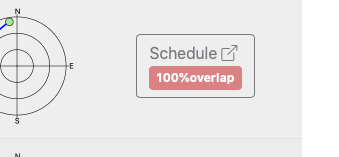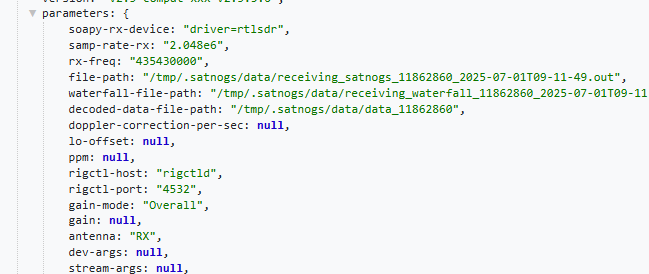Hi, I´m a newbie in Satnogs, I’m sure hardware is OK but can’t schedule nor waterfall… always “Satellite is always below horizon or no free observation time available on visible stations”… what’s wrong? can anybody test my station? thanks.
It looks ok here… what steps have you followed, which satellite have you chosen?
Steps I followed:
- Went to your station page SatNOGS Network - Ground Station EB1GER
- Click on the future passes panel, a list with passes showed up after some seconds
- Clicked Schedule button in one of them and moved to scheduling page
- There I clicked schedule and the selected pass was scheduled
Hello, thank you for your quick response. Something strange has happened because now I get a new button that wasn’t there before… I’m going to try again to see if it works now.
Yes this is probably from the observation I’ve scheduled.
This shows that the specific pass is 100% overlapped from something scheduled already in your station. In this case, if it is 100% you can not scheduled on it, but if it is less than that, ideally less than 50% then you can schedule the non-overlapped remaining pass of the satellite.
Scheduling and observations looks to work now. I notice your rtl-sdr gain is set to zero
Try something like 29.7 for a setup with no lna.
Thanks for your help, I am doing tests and I am finally starting to receive something, what are the easy satellites to adjust the station? The next step is to use dedicated antennas but I need a little more time to organize the shack… ![]()
Run the antenna / sdr setup attached to a computer. Run SDR software on that computer and check for the optimal gain values for the different frequency bands of interest.
Rule of thumb is, if you change the gain with 3 dB and the noise floor jumps over 3 dB up there is to much gain. If you add 3 dB gain and the noise floor barely goes up try another 3 dB
For me, I’m testing my station first using NOAA satellites for VHF (15 and 19, bear in mind the NOAA 18 was already turned off sadly) or FUNCUBE-1.
On UHF I’m testing mine on OTP-2 or any voice repeater satellites that has the UHF downlink: ISS, SO-124, SO-125 or AO-123 (Please check here whether the repeater was on or not AMSAT OSCAR Satellite Status)
And here’s a useful tutorial guide from the wiki: Omnidirectional Station How To - SatNOGS Wiki (which basically @pe2bz has sumarized above).
Please bear in mind I’m not an expert on this matter; I just built my station a month ago but those I mentioned above has helped me adjusting my station ![]()
Hope that’d help and have fun!
Very good idea, tanks. ![]()
I´m testing it but I think that 50m of coaxial cable don’t help too much. I’m planning to install the Pi in a storage room very close to the roof and change the antenna for a collinear one, so with 7m of coaxial it would be enough and I’m sure the signals would be much better, but I have to wait a little… while I continue experimenting.
Thanks to everyone who is helping me.
A co-linear antennas are designed to have a very low angle of radiation? Hence the perceived gain.
Satellites are usually fairly high in the sky above 30 degrees or so. An antenna with a high angle of radiation, like a QFH, would be more useful. I learned this the hard way. My homebrew QFH antennas work much better for satellites than my co-linear vertical.
Hello, thanks for the note, indeed the lobe of radiation from a collinear antenna is not ideal, but it is what I had planned to put. Searching among the aluminum in the garage I found a logo periodic from CREATE that I no longer remembered, I connected it facing west and resting on the roof, with little elevation. It has been working since last night with that configuration and I have improved the reception, but it has the problem that I can’t guide it yet… I keep experimenting… Thanks again. ![]()
Try pointing it straight up. I run a TinyGS station on around 433MHz, like this by using one of my unused UHF yagies straight up, which gave me many more decodes.
I agree on pointing it straight up, the log-periodic sill has a quite wide lobe so a rotator isn’t strictly needed.
I know many of the TinyGS stations use collinears, and the argument being that it has higher gain at the horizon where the signals from the satellites are the weakest, but it has a deep null straight up.
The QFH is seriously good, but hard to build or buy.
People,
A pretty good alternative to the excellent QFH is the ATA antenna. Google it. They are a bit like a turnstyle but with the driven elements canted down at about 45 degrees. At 430MHz they are small and pretty simple to build using a bit of PVC and some brazing rods. I have these on my UHF SatNOGS stations.
Hope this helps. John VK4JBE
I totally agree. ATA is the simplest antenna to built if you want to receive from satellites. I made one for 137Mhz NOAA and the result is quite nice. Not as great as QFH but much more easier to built.
I get the design from here:
Asymmetric Turnstile Antenna
For UHF there’s also this, which again not as great as QFH but really easy to build if you have access to 3D printer.
I have built many QFH antennas. There is a good ‘Howto’ if you search QFH antenna on google.
I made one for 2m and one for 70cm, using copper tubing. Yes, a big pain, never again. I found some stiff hard drawn ex telephone wire, removed the insulation and built 6 or more QFH antennas using irrigation standoffs for spreaders high pressure plastic pipe as a vertical support. They have been up there for many years. Bob vk2byf
Building the QFH as self supporting is prettier (maybe sturdier) but also physically demanding ![]()
I made my UHF from 5-6mm copper brake like and drew the coax through one of the legs.
My VHF one is not finished, but is based on 12mm soft annealed copper pipe.
My guess why they work so well is partly being broad band (depends on element thickness) at the design frequency, but the DC-short also means they are less sensitive to lower frequencies and noise.
There’s of course DC-shorted dipole and yagi designs, and they probably benefit from this as well. For example, search for “aerial oy dipole”. Having the elements DC-grounded and shorted is a very robust design.
Seems the link doesn’t work anymore, repo looks deleted. Can be found on the archive.
Thanks!
That’s unfortunate. I just realized the whole Github page of DerekSGC just went missing.

